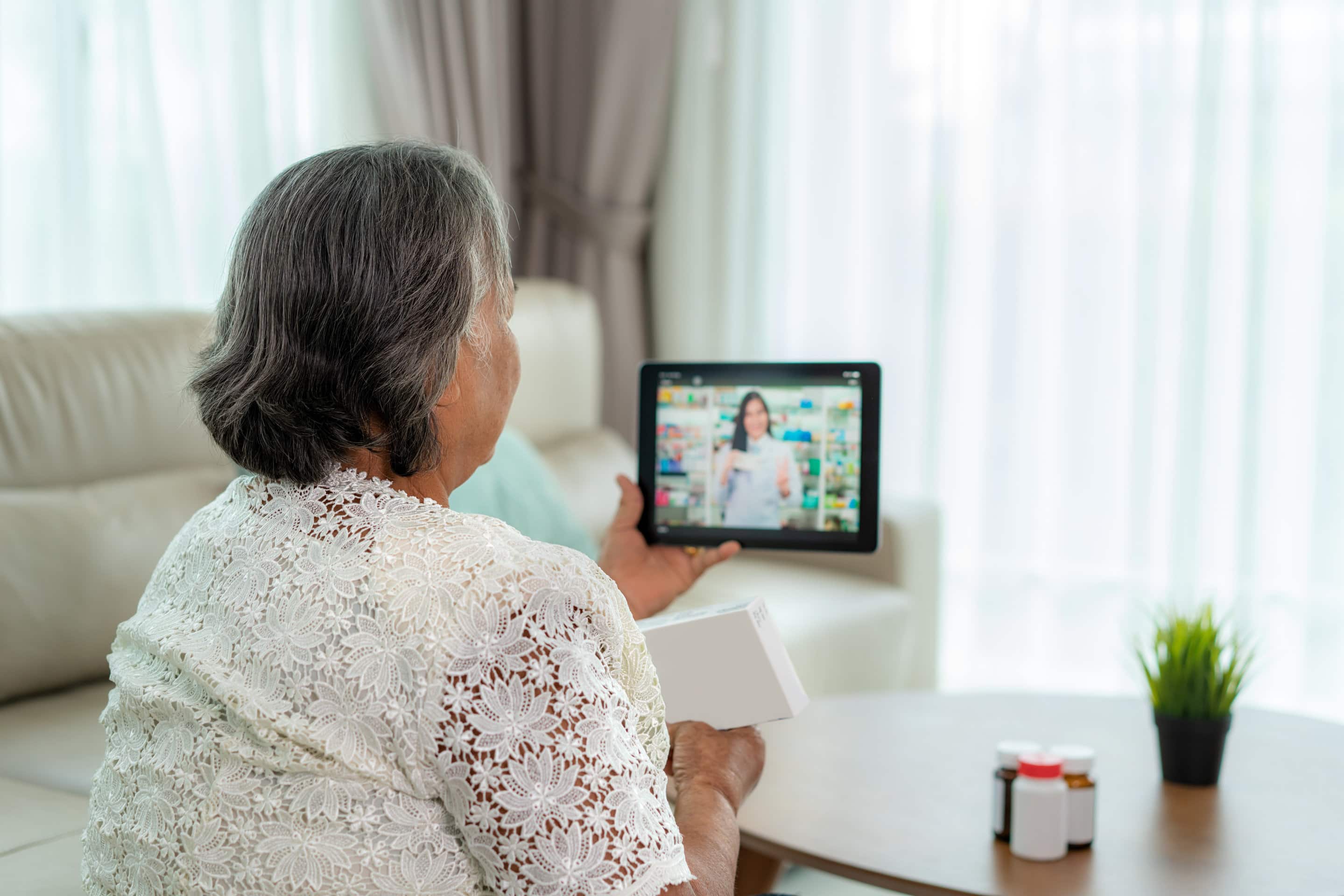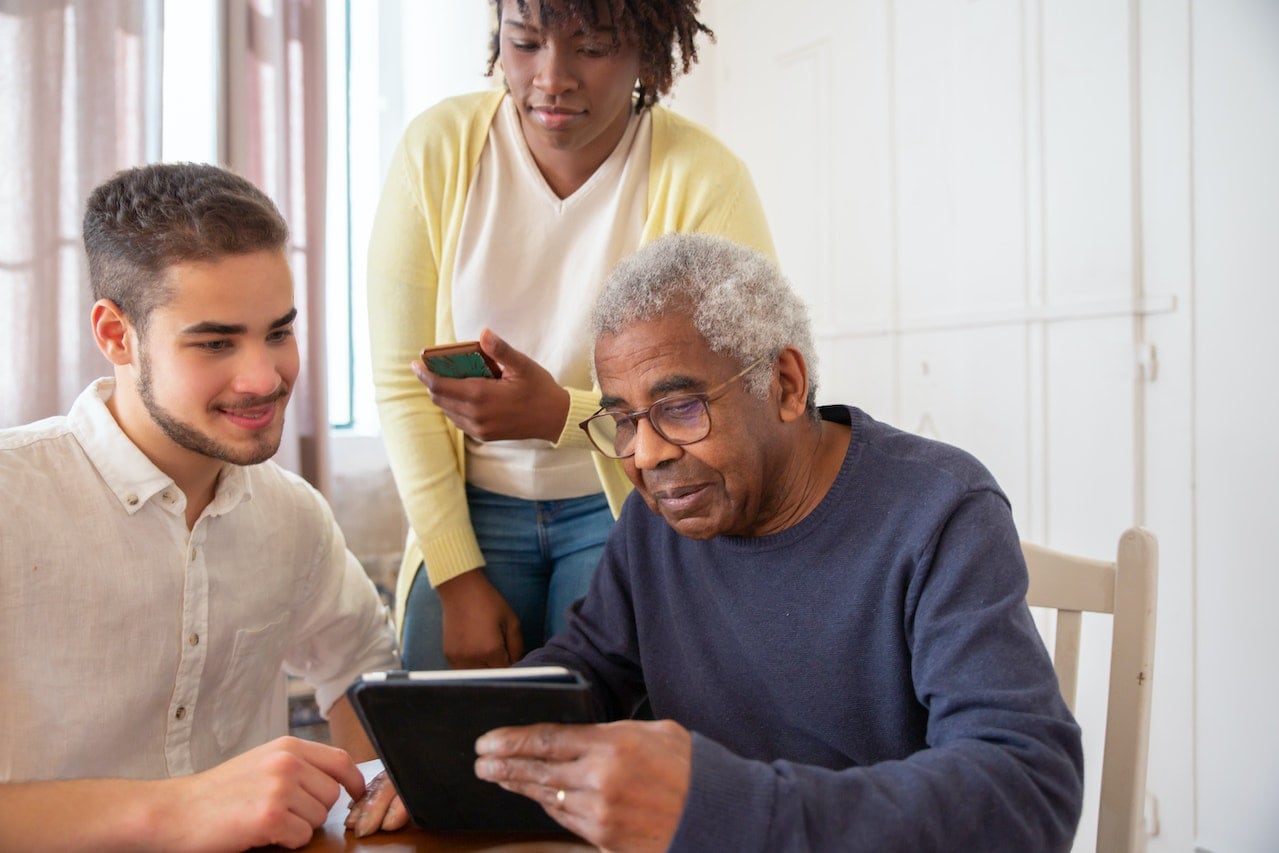Chronic disease management: Best virtual healthcare options
Middle-age is when most adults are diagnosed with a chronic health disorder such as hardening of the arteries and diabetes (Type-2). Once a chronic disease has been diagnosed, it requires lifelong management so symptoms do not worsen. Healthcare check-ups to see whether medication prescribed to manage the disorder is actually working are common. For senior-aged people and other adults with disabling symptoms, virtual healthcare offers a way to have physician check-ups, request prescription re-fills, and obtain answers to questions without having to visit a doctor’s office.
According to the Centers for Disease Control (CDC), 37% of adults used virtual healthcare in the form of telemedicine in 2021. Virtual healthcare options differ tremendously, and some are easier for senior-aged adults to use than others. A Forbes magazine article in 2021 described six of the best virtual healthcare options available at that time. Topping its list was Teladoc, which is an “on-demand” service that connects a caller to a healthcare clinician and is covered by various health insurance plans (including some Medicare Advantage plans). Meanwhile, advances in Artificial Intelligence (AI) are enabling the design of apps focused even more specifically on supporting adults living with chronic health diseases.
Four types of telehealth available on apps for patient care
There are four different types of telehealth that are available either separately or in combination with each other (per the Center for Connected Health Policy). These are most often called:
- Live video (which uses teleconferencing software, and enables “real-time” interaction between a patient and healthcare provider).
- Store-and-forward (which involves electronic transmission of medical information such as documents, digital images, and pre-recorded videos).
- Remote patient monitoring (which involves personal health and data collection that is transmitted to a healthcare provider for use in providing care and support to that patient).
- Mobile health (which are basically healthcare and public health “best practices” and education supported by mobile technological devices such as Smart Phones).
For people with chronic health disorders, the utilization of all four types may be advisable in order to prevent the necessity of frequent “in-person” healthcare visits. In particular, receiving daily reminders to take medication (or to remember an upcoming “in-person” or virtual appointment with a clinician) can be beneficial for elderly people with cognitive impairments. In this way, receiving virtual healthcare can potentially enable a person with mild dementia to remain in the home environment for more years, rather than be relocated to a nursing home.
Encryption, virtual telehealth services, and videoconferencing
A medical research article in 2022 in Clinical Liver Disease noted that healthcare providers need to comply with the federal law called HIPAA that is focused on protecting patient privacy. For this reason, it specifies that platforms such as TikTok, Facebook Live, and Twitch are not acceptable for telehealth interactions. While Zoom (which is frequently used for social group events and business meetings) is among the most popular videoconferencing platforms, it lacks the encryption required for HIPAA compliance. In contrast, some platforms such as Doxy.me are HIPAA-compliant.
Health insurance and virtual healthcare
Consequent to the Covid-19 pandemic, more health insurance companies than ever are covering the cost of virtual healthcare visits. Medicare coverage for telehealth was flexible during the declared federal Covid-19 public health emergency ending on May 11, 2023 (but with an extension of many Medicare telehealth coverage provisions through December 31, 2024). Moreover, an increasing number of Medicare Advantage plans are offering broader coverage for telehealth, including covering the cost of certain digital devices. Meanwhile, mental health therapists are typically paid 20-30% less for virtual therapy sessions as compared to “in-person” sessions, which is a likely reason that many health insurance companies are now covering the cost of virtual therapy sessions.
Low-income senior-aged people are far more likely to be affected by chronic health disorders than their higher-income counterparts (per a medical research article in Healthcare). Yet, Medicaid plans (that are state-administered) do not cover virtual healthcare as extensively as Medicare or private health insurance plans. Therefore, low-income seniors may not be able to afford the “out-of-pocket” costs in the form of co-pays for virtual healthcare that is required of them.
Mental health and substance abuse treatment: How virtual healthcare can save lives
Federal law (the Paul Wellstone and Pete Domenici Mental Health Parity and Addiction Equity Act of 2008 [MHPAEA]) basically specifies that group health plans and health insurance issuers that provide mental health or substance use disorder benefits cannot limit these benefits to an extent greater than the limits on the medical/surgical benefits. It is well-recognized that adults with chronic health disorders are more likely to experience mental health disorders (such as clinical depression and anxiety) than adults without chronic health disorders.
Early intervention for a mental health disorder can prevent development of dependency upon a substance (such as alcohol) for self-medication. Since a mental health disorder and/or substance abuse problem is linked to decreased self-management of chronic health disorders, access to virtual mental health therapy and substance abuse treatment for adults with chronic disorders may lessen the likelihood of worsened overall health status. Thus, this type of virtual care may be life-saving.
Partner with Ōmcare
With the Ōmcare Home Health Hub’s open API integration, you can run your telehealth services directly on the Hub – eliminating the need for disparate solutions that account for hardware. Partner with us to reach more people and ensure better health.
Employee Spotlight: Danielle Wiek
Name: Danielle Wiek
Title: Accounting & HR Manager
Time at Ōmcare: 6 years
1. What’s the most rewarding part of working at Ōmcare?
I love being part of a team that is developing a product that will truly help people have a better quality of life, with the right medication at the right time.
2. What is your favorite current project you’re working on?
Onboarding our new team members is always rewarding for me. I get the chance to make connections and assist them in being more comfortable when transitioning their careers to Ōmcare.
3. Pick out a core value that means a lot to you. How have you seen this lived out in your time at Ōmcare?
WE are a Team; It’s fun to watch when collaboration happens. The different views and ideas that everyone has brings our product to a new level.
4. What are you most proud of accomplishing throughout your time at Ōmcare?
Throughout my time at Ōmcare, I am most proud of the growth and knowledge I have acquired from wearing multiple hats including Accounting, HR, Administrative, and Customer Care. All these responsibilities have brought me a unique perspective into each part of the company and allow me to look at everything in a bigger picture context.
5. Why should someone work at Ōmcare?
Ōmcare is a small but mighty company that has good benefits, flexibility, values, and amazing coworkers.
34% of consumers are digitally inclined: Implications for the healthcare industry
An analysis of healthcare-focused survey data revealed that 34% of the entire US adult population is now digitally inclined, and interest among the senior-aged is surging. While preventing infection with Covid-19 prompted many Medicare-aged adults to schedule telehealth physician visits, there are other reasons that adults aged 65+ are more willing than before the pandemic to utilize technology-based healthcare services. From reminders to take medications to disease-specific health education – and individual wellness checks to answering patient questions – the use of wearable devices and digital healthcare platforms by the elderly is significantly growing.
Due to the potential for improved overall health status, senior care facilities and Medicare providers (including Medicare Advantage providers) are focusing more attention and resources on this trend. As of 2021, at least one in five nationwide healthcare leaders reported that their organization/practice offers remote patient monitoring. Described below are some of the different digital approaches to improving senior health status that are being embraced by senior caregiving facilities and clinicians, as well as by more healthcare payers. Diverse ways that digital healthcare delivery approaches can reduce costs are also discussed.
Digital health education as a chronic disease management tool
The American Diabetes Association notes that 29.2% of all adults aged 65+ in the US have diabetes. Even more have a condition termed pre-diabetes that – with lifestyle changes – may be controlled such that progression to full-blown diabetes (Type 2) does not occur. Since obesity is highly linked to developing diabetes, digital wearables can calculate both the total calories consumed in the food eaten and the reduction in weekly caloric intake needed to lose a targeted amount of weight (in pounds).
While Fitbit and similar fitness trackers can aid in enabling a plan for weight management or loss, other types of digital wearables are more focused on aiding people diagnosed with prediabetes or diabetes to understand their daily glucose (blood sugar) intake from the foods eaten – so can promote both weight loss and lowered glucose intake. Moreover, they can include a “chat” feature to answer questions about caloric and glucose content in a specified amount of a desired food item, so that the individual can decide whether to consume it or not.
Other chronic disorders such as heart disease and Chronic Obstructive Pulmonary Disease (COPD) can also require major lifestyle changes. By utilizing a wearable that offers digital health education, the afflicted person can learn how to better manage a newly-diagnosed condition or acquire informative reminders if a medical provider’s instructions are forgotten.
Medication management: How digital platforms and digital wearables are useful
Many senior-aged people take more than one prescribed medication each day. Two of the most common are cholesterol-lowering medication and antihypertensives (that control blood pressure). More than four in every 10 elderly people take at least five prescription drugs per day – which is a three-fold increase as compared to 20 years ago. Although this has enabled many to live “better” and enjoy a far longer lifespan, it can also be confusing for these people to keep track of all of their daily medication. Therefore, more intensive medication management by the individual (or that person’s personal caregivers and medical providers) is needed to reduce medication intake mistakes.
For adults aged 65+ residing in assisted living facilities as well as alone, recognizing negative effects from skipping a medication or accidentally taking more than the prescribed dose can be problematic. Meanwhile, elderly people with early dementia (such as early Alzheimer’s Disease) can tremendously benefit by a digital device that provides real-time reminders of which prescribed drug to take and when to take it.
Furthermore, patients with a history of nonadherence to their medication can benefit from a digital call from a member of the healthcare team (or even a nurse care coordinator from that person’s insurance plan) to ensure that the needed medication are being utilized. (This is particularly useful for a senior-aged person with a past history of stroke prescribed a daily blood-thinning drug to prevent another stroke, but who forgets to take the drug due to forgetfulness resulting from the stroke.)
Wellness and safety checks to relieve stress on caregivers
Around 28% of community-dwelling senior-aged adults live alone, and that number sharply increases after age 75. According to Harvard University’s Joint Center for Housing Studies, the number of people aged 80+ who are living alone is set to soar to an estimated 10.1 million by 2038. “Slip and fall” accidents are the most frequent causes of bone fractures and death in adults aged 65+, and over 800,000 are hospitalized annually due to a fall-caused injury. One of the most common reasons is waking in the middle of the night to use the bathroom, and then losing balance due to suddenly standing up from a lying-down position with resulting light-headedness.
Utilizing a wearable digital device to dial for assistance in the event of an emergency is just one way that an elderly person who has fallen can obtain immediate aid. Another is a periodic call from someone (to ensure that the elderly person does not need immediate aid) in the form of a wellness and/or safety “check”. Through the capacity for periodic contact from a paid caregiver, family member, designated friend, or healthcare provider, prevention of a worsened healthcare outcome for the senior-aged person can be enabled. Likewise, it can also alleviate the anxiety and fear on the part of loved ones as to the health status and/or safety of that senior-aged person.
The federal Agency for Healthcare Research and Quality (AHRQ) in 2020 reported that preventable hospitalizations among adults as of 2017 cost the US $33.7 Billion, and such hospitalizations occur most commonly among senior-aged adults. Therefore, insurance companies and healthcare organizations/facilities alike (as well as the patients themselves) are bearing preventable costs that digitally-initiated wellness and safety checks may curtail.
Focus on Dementia: The importance of digital wearables to support patient functioning
An estimated 6.5 million adults aged 65+ in the US were living with Alzheimer’s Disease as of 2022. That number is expected to triple by 2050 (and one in three seniors is living with some form of dementia by the final year of life). Since dementia is highly associated with failure to take medication as prescribed, “slip and fall” accidents, and preventable hospitalizations, it is also linked to the overall increased cost-burden on the national healthcare system.
When Alzheimer’s Disease is diagnosed at an early stage, interventions to promote cognitive functioning (such as engagement in online “brain health” games and programs) can be initiated to help prevent the afflicted individuals from experiencing a more rapid decline in cognitive functioning than otherwise. As noted in an article in Frontiers in Neurology in 2020, lifestyle modifications and enhanced social support may delay the need for nursing home care, while also reducing the patient’s overall healthcare costs resultant from living with dementia. In particular, involvement in visual art-making activities has been shown to improve cognition and relieve anxiety in people with Alzheimer’s Disease (and other forms of dementia), per a medical research article in Cochrane Database Systemic Reviews.
Physical fitness and health status: Changed insurer attitudes toward fitness wearables
Reducing healthcare costs is a persistent issue for private health insurance companies targeting the senior-age demographic, as well as the US Centers for Medicare and Medicaid Services (CMS). Since physical fitness has been linked to both preventing numerous chronic diseases and decreasing the rate of age-related bone loss (osteoporosis), coverage of the cost of fitness trackers has been embraced by an increasing number of health insurers, as described by AARP.
Meanwhile, a Fierce Healthcare article in 2022 reported that Humana is using wearable fitness tracking devices it distributed to enrollees to track data on their chronic conditions in order to encourage embracement of healthy behaviors. Likewise, United Healthcare in 2023 is rolling out a financial rewards program for its enrollees using provided wearable digital tracking devices who meet their daily exercise goals (or other healthful activity goals).
By utilizing the data obtained from health-related digital wearables, insurers are better able to predict (and adjust for) upcoming year costs related to preventable chronic disorders. (While Medicare does not specify technological devices or wearables in its coverage language, it does cover “medically necessary” Durable Medical Devices [DMEs) – so it is likely that more digitally-driven DMEs will be covered in future years.) Meanwhile, a Health News article in 2023 suggests that current coverage of digital wearables as an added plan benefit (such as a fitness tracker or personal emergency alert system) are far more likely under Medicare Advantage plans.
Digital wearables, telehealth, and teleconferencing
Talking to a clinician as needed is a way that patients can stick to action plans for recovery at home following different types of surgeries (and also action plans for addressing early symptoms of disorders that require medical attention). For example, patients that are recovering at home following hip or knee replacement surgery – and are participating in post-surgery Physical Therapy (PT) sessions – may benefit from initiating a video call with their physical therapist to boost the likelihood of daily performance of the prescribed exercise regimen.
Since mental health can affect overall health and well-being, it is also a way that clinicians can remain abreast of their patients’ mental health status. Especially for patients with cognitive impairments, being able to talk to someone via a digital device can improve compliance with medical (and allied) provider recommendations for maintaining overall health.
Visit Ōmcare to learn more about our digital solution that provides a one-touch access point to provided services through our digital hub.
How to make telehealth more accessible for seniors
Driving to a healthcare appointment can be more difficult for a senior-aged person, as can acquiring a ride to a doctor’s office. Difficulty with mobility, decreased eyesight, and increased fatigue can all pose an obstacle to keeping appointments with medical providers. For this reason (and many others), telehealth has been a viable and welcomed option for many seniors and their family members. According to the Journal of Applied Gerontology in 2022, older adult utilization of video-based telehealth in place of “in-person” primary care physician visits has increased by 21% since the beginning of the Covid-19 pandemic.
Additionally consequent to the Covid-19 pandemic has been an increased interest on the part of older adults in acquiring online communication skills. The Pew Research Center (PRC) in 2022 reported that 95% of all adults aged 30-49 (and 44% of all adults aged 65 and older) now own a Smartphone. Meanwhile, the PRC also reported that 44% of adults aged 65 and older own a tablet computer (as compared to 53% for those aged 50-64). However, telehealth is inaccessible to many seniors for reasons other than lessened mental sharpness (although decreased cognitive ability can lessen telehealth accessibility for affected elderly adults).
The following are five ways to make telehealth more accessible to adults who are senior-aged:
1. Simplify Interface Interactions to Only Pressing One or Two Keys to Start the Telehealth Communication
Joint pain in the hands and fingers due to arthritis is common in older-aged adults, and around 47% of seniors aged 65+ have been diagnosed with arthritis. This can make manipulating keyboards and pressing buttons on computerized devices painful and difficult. Likewise, the common vision disorder of presbyopia – that makes reading small print more difficult – affects most older-aged people. When there are many keys or buttons to press to turn on (or turn off) the telehealth communication, this can increase the likelihood that an incorrect key or button will be pressed. Due to the frustration experienced in starting the software program, utilizing a wearable device, or needing significant manual dexterity to engage in the telehealth communication, a senior-aged person may simply give up.
2. Set the Audio to the Loudness Required by the Senior to Hear the Telehealth Communication
Hearing loss affects one in every three people aged 65-74 in the US, according to the National Institute on Deafness and Other Communication Disorders (NIDOCD). Many adults aged 65 and older wear hearing aids, but these can increase the overall decibel level without enabling a better ability to hear words over background sounds. Therefore, hearing a telehealth communication (whether it is an interactive video call with a medical provider or just a reminder to take a particular daily medication) can be problematic for some seniors. In order to decrease the likelihood that a hearing impairment will interfere with utilizing telehealth, it is important that the Smartphone, tablet, or computer be able to be set as loud as needed by the senior-aged person.
In addition, captioning should be enabled so that the senior-aged person with hearing loss can utilize this if necessary. Moreover, the ability to read the caption while hearing the words spoken may improve the understanding of the verbal message during the telehealth visit.
3. Ensure that the Technological Device is Working Properly Prior to Any Telehealth Interaction
Whether the technological device is a desktop (or laptop) computer, tablet, or wearable, checking it intermittently to ensure that it is actually functioning is essential. Since many senior-aged people are not technologically savvy and insecure about their high-tech abilities, they may think that they are utilizing the telehealth-related software incorrectly when the problem lies in the computer hardware or merely a “low” battery that needs re-charging.
While it is better for someone who has an adequate enough level of technology skill to check the computer for the elderly user to ensure it is working properly (and especially that it stays on after the power button is pressed), an alternative is to “walk” the senior periodically through the steps of this hardware check, to ensure that a telehealth interaction can actually occur.
4. Do Not Change the Appearance of the Computer Screen after Installing Software Enabling Telehealth Utilization
People who are not highly familiar with using computers (such as many elderly people) can learn to use them, but the confidence level can be shaky due to unfamiliarity with high-tech devices. If learning has occurred on a screen with a specific appearance (such as the icon for the telehealth-related software and other icons in certain positions on the screen), moving them can cause confusion for the elderly computer user.
According to a medical research article in Seminars in Hearing, cognitive changes occur during later-life aging that often impact the nimbleness of that elderly person to adapt to changed information to make a decision. Therefore, a changed computer screen appearance can create doubt in the mind of an elderly person with a minimal level of computer skill as to how to use that computerized device. Furthermore, this confusion can lead to not realizing that the icon to connect to a clinician for a telehealth interaction is actually the same as always – but just appearing in a different place on the screen!
5. Ensure that Seniors have Access to a Reliable Internet Connection
Thirty-nine percent of all adults aged 75+ have lived in their current home for more than 30 years (per the Urban Institute). Therefore, the Internet connectivity capability may not be sufficient for that necessary to engage in a telehealth interaction. Meanwhile, there are diverse other causes of “spotty” or nonexistent Internet connectivity. One major cause is residing in a rural geographic area, where broadband lines can be distant. Meanwhile, 43% of adults living on an annual income of less than $30,000 in the US do not have at-home broadband, and around 10.3% of all seniors are living below the poverty line.
Whatever the reason for the lack of reliable Internet connectivity, telehealth requires that a person be able to depend on such connectivity. Otherwise, a telehealth visit may be scheduled by a physician or other healthcare provider but the patient not be able to participate in the virtual visit due to the Internet connection not functioning. On the other hand – if basic Internet connectivity is not a problem – enabling senior-aged people to understand how to acquire an Internet Service Provider (ISP) and a connectivity speed appropriate to their circumstances/needs can improve the likelihood that they will be interested in utilizing telehealth services.
The Ōmcare Home Health Hub® is a technology product that includes a mobile app and the capacity to engage in telehealth video calls for check-ins and check-ups, so can aid seniors while aging at home.
Changes for Medicare Advantage in 2023
Every year, Medicare Advantage plans change slightly. These changes can be confusing, which is why we’ll be explaining all the Medicare Advantage changes you’ll experience in 2023.
First, what is Medicare Advantage?
Medicare is federally-funded health insurance, designed to get you the care you need at a lower cost. Medicare Advantage gets you more coverage than Original Medicare—for example, your Medicare Advantage plan will often cover prescription drugs, while Original Medicare plans won’t.
What do Medicare Advantage plans typically cover?
Medicare Advantage usually covers all three Medicare Parts:
- Medicare Part A: Covers hospitalizations. You usually won’t pay a premium for this, however, there’s a small chance you won’t qualify for premium-free Part A. If that’s the case, you can purchase premium-free Part A.
- Medicare Part B: Covers medical insurance (non-emergency). Every Medicare Advantage enrollee pays a monthly premium for Part B.
- Medicare Part D: Covers prescription drugs. Only some Medicare Advantage plans offer this coverage.
Medicare Advantage changes in 2023
Here are the changes to Medicare Advantage plans that you should be aware of:
1. Cost
In 2022, the average Medicare Advantage enrollee paid $19 per month. In 2023, the average monthly premium for Medicare Advantage enrollees is decreasing to $18 per month. This means you’ll be paying less for the same great coverage.
The lower costs are a result of the Biden-Harris Administration and its efforts to make healthcare more affordable. “Thanks to President Biden’s Inflation Reduction Act, millions of Medicare enrollees will have lower prescription drug costs and improved benefits when they sign up this year,” said HHS Secretary Xavier Becerra.
2. Maximum out-of-pocket limit (MOOP)
In 2023, the Medicare Advantage maximum out-of-pocket limit (MOOP) will increase to $8,300, from $7,550 in 2022. This means that after you spend $8,300 on Medicare services, your plan will cover the rest of your covered care costs for the rest of the year.
However, most Medicare Advantage plans have lower out-of-pocket limits than the established maximum. Ask your insurer what your out-of-pocket limit is.
3. Expansion
Depending on what state you live in, your access to Medicare Advantage plans are limited. This may have caused problems for you in the past, but in 2023, five major Medicare insurers are planning to expand into new states and counties. You’ll have new options from:
- Aetna
- Cigna
- Elevance Health (which used to be known as Anthem Inc.)
- Humana
- UnitedHealthcare
The expansion of Medicare Advantage insurers will help more people get great coverage.
4. Drug coverage
If your prescription drugs are covered, you’ll see a two important changes to your coverage in 2023:
- For certain types of insulin, you’ll pay no more than $35 per month.
- The Advisory Committee on Immunization Practices (ACIP) recommends certain vaccines, and all of these will be free. These include: COVID-19, HPV, measles, polio, smallpox, and more.
With the changes to Medicare Advantage drug coverage, you can expect to save money.
Quick summary
Here’s a summary of all the 2023 Medicare Advantage changes:
- The average monthly premium will be $18.
- The maximum-out-of-pocket limit is increasing to $8,300.
- Medicare Advantage plans will be offered in more states and counties.
- Insulin costs will be capped.
- Recommended vaccines will be free.
Ōmcare engages with Medicare plans
Ōmcare is actively engaging with Medicare Advantage plans to help bring technology into your home as part of the costs you already pay. Our goals are to increase healthcare access, improve health outcomes, and maximize care for what you already pay.
Learn more about how we partner.
What is Medigap, and does it cover prescriptions?
If you’re worried about affording your healthcare costs, you’re not alone. 37% of adults age 65 and older are concerned that they won’t be able to afford their healthcare expenses within the next year. As the cost of care rises, it’s wise to consider all the insurance options available to you — including Medigap.
Today, we’ll help you understand what Medigap is, how it can help you manage healthcare costs, and whether or not it pays for prescription drugs.
Understanding Medigap: What is it?
Medigap is also known as a Medicare Supplement, because it can help you pay for healthcare expenses that aren’t covered by Original Medicare. Medicare writes that Medigap “helps fill ‘gaps’ in Original Medicare and is sold by private companies.” Some of these gaps include:
- Copayments
- Coinsurance
- Deductibles
To have these expenses covered, enroll in a Medigap policy on top of your Original Medicare policy. You can buy a policy from any insurance provider that’s licensed to sell in your state, but you and your spouse will need your own separate Medigap policies.
Does Medigap cover prescription drugs?
While Medigap helps you pay for some healthcare costs, it doesn’t help you pay for all of them. Most Medigap policies will not pay for any of your prescription drugs and medications.
Medigap doesn’t cover prescription drugs.
Since Medigap won’t help you pay for your medications, it is not the best option if you have a condition that requires you to take a lot of prescriptions. Likewise, if your prescriptions are really expensive, Medigap is not the best option for you.
On the flip side, if you don’t have many monthly medications, or your medications aren’t too expensive, a Medigap policy may be perfect for you.
Other options: Paying for for prescription drugs
If you do need expensive prescription drugs on a regular basis, Medigap won’t help. But this isn’t a dead end—other insurance options can help you pay for your monthly medications.
Here are some other insurance options to consider:
- Coverage from a former employer or union.
- Medicaid, which provides healthcare assistance to people with limited income and resources. Medicaid can help you pay for your medications, but it does depend on what state you live in.
- Medicare Advantage, which covers more healthcare costs than Original Medicare. Some plans offer Part D coverage, which means it will pay for your prescription drugs.
If you do decide to go with a Medicare Advantage policy, you can’t buy and won’t need Medigap.
Quick Summary
We’ve just covered a lot of confusing information. Here is a quick summary of it:
- A Medigap policy can help you pay for healthcare expenses that Medicare doesn’t—including copayments, coinsurance, and deductibles.
- A Medigap policy won’t help you pay for prescription drugs.
- If you need pricey prescriptions on a regular basis, some Medicare Advantage will cover the costs for you.
Ōmcare engages with Medicare plans
Ōmcare is actively engaging with Medicare plans to help bring technology into your home as part of the costs you already pay. Our goals are to:
- Increase healthcare access
- Improve health outcomes
- Reduce costs
Learn more about how we partner.
Senior care facilities: How to help elderly patients reduce healthcare costs
25% of elderly Americans sacrifice their basic needs to afford healthcare costs. Even with these sacrifices, 50 million American adults aged 50 and older are at risk for illness progression—and even death—because costs are still too high.
The situation is getting even worse as inflation strains the United States economy. The cost of basic needs, healthcare, and senior care facilities are rising, but social security checks remain stagnant.
By helping your seniors embrace technological advances, you can help reduce the burden of healthcare costs.
Reducing healthcare costs: Technology’s role
A few decades ago, seniors were reliant solely on in-person healthcare, which gets pricey very quickly. Fortunately, this is no longer the case due to recent advancements in healthcare technology. Patients can now more effectively manage their health issues virtually, at a fraction of the price of in-person care.
Seniors pay an average of $7,030 per year on healthcare, which is 13% of their total spending. On top of nursing home costs, these fees are often very challenging for seniors to handle, even when they have Medicare.
Healthcare technologies in the market help seniors spend less on healthcare—for example, Ōmcare Home Health Hub only costs $9 per month—because they provide a solution that reduces the need for healthcare employees day-to-day. Longterm, these technologies reduce costly hospitalizations.
How to help seniors reduce healthcare costs
There are three main alternatives to in-person healthcare: virtual care, remote patient monitoring, and medication management.
Virtual care
Virtual care allows your seniors to speak with their physician, receive diagnoses, and learn about their treatment plans—all from inside your facility. A medical care professional provides services through video chats, voice calls, or text messages.
With virtual care, patients get the care they need, at a far lower cost. The reduction in cost is why many people choose to use virtual care: a RAND study found that “people who preferred video visits were more sensitive to out-of-pocket costs than those who preferred in-person visits.”
Despite the reduction in costs, quality of care remains the same. The RAND study found that only 2% of those who had a video visit were unwilling to do so again. That means patients are content and happy with the outcome of virtual care. To make virtual appointments as effective as possible, have an employee accompany your seniors, while taking detailed notes.
Remote patient monitoring
Virtual care is increasingly effective when paired with remote patient monitoring. Using remote patient monitoring, healthcare providers can monitor and manage a senior’s chronic conditions. When any issues arise, they can see the data. They can spot the issue and deliver virtual care.
By monitoring vitals 24/7, remote patient monitoring:
- Reduces and shortens hospitalizations
- Decreases emergency room visits
- Prevents long-term health complications
- Reduces risk of getting infected with COVID-19 and other illness
When your seniors are healthier and dealing with less complications, they face fewer healthcare costs. Remote patient monitoring also helps your facility and your seniors cut any travel costs.
Medication management
A key aspect of managing chronic conditions is medication adherence. Unfortunately, seniors are likely to forget to take and refill their medications—leading to $100 billion in preventable medical costs every year.
Why does medication nonadherence cost so much? The answer is that when seniors aren’t properly taking their medicine, they’re 25% more likely to be hospitalized. That leads to a major hike in emergency healthcare costs.
To avoid hospitalizations, use healthcare technologies that were created specifically to help seniors manage their medicine. These include:
- Automatic pill deliveries
- Pre-sorted pill packages dispensed at the right time, in the right dose
- Text message, email, or call reminders
- Automatic refills
- Adherence tracking
Medication adherence technologies help seniors stay on track of their proper dosage schedules, leading to less health complications and less costs.
Boosting healthcare tech adoption
No matter what healthcare technology you’re introducing to your facility, follow these tips to improve adoption among your seniors:
- Find simple, intuitive technologies that are easy to use, with few, well-marked buttons.
- Make sure the technology is accessible for seniors, with features like larger text sizes and speech-activation.
- Provide well-written, easy-to-follow instructions.
- Offer extra in-person technology coaching.
- Assure seniors that their data is safe—only 1 in 10 seniors feel confident that their interactions with healthcare tech will be kept private. Address these privacy concerns.
- Educate seniors on how the technology will help them, improve their health outcomes, and reduce their costs.
And finally, make sure your technological options are actually affordable to your seniors. One way to increase affordability is finding a technology that offers many key features in one.
Ōmcare brings it all together, for less than $10 a month
If you’re looking for an all-in-one healthcare solution that allows for virtual care and medication adherence, consider the Ōmcare Home Health Hub. The technology:
- Stores up to a 30-day supply of multi-dose pouched medication
- Provides a video portal for medication adherence tracking
- Connects patients with providers virtually
Our 3-month pilot showed that the Ōmcare Home Health Hub drove a 98% dose-level adherence rate. At the end of the pilot, all 780 participants strongly agreed that Ōmcare helps them remember to take their medications.
Drive positive health outcomes for your seniors and help them cut their healthcare costs by partnering with Ōmcare for just $9.99 a month per patient. Learn more today.
4 top technological solutions to improve medication adherence for Medicare Advantage
55% of senior patients are noncompliant with their medication schedules, which is an issue for Medicare Advantage plans given 41% of the Star Rating depends on beneficiaries properly taking their medicine—especially medications for diabetes, cholesterol, and hypertension.
Having a high Star Rating is key to earning more enrollees—90% of Medicare beneficiaries are enrolled in a plan with a 4.0 rating or above. Focus on improving medication adherence to positively impact your plan’s Star Rating.
To improve medication adherence, we first have to understand why seniors aren’t taking their medicine properly.
Understanding the reasons behind medication non-adherence
Some of the top reasons for medication non-adherence include:
- Forgetfulness: This is the cause in 63% of cases.
- Complex regimen: Having too many medications to manage.
- Medication schedule is too confusing: 36% of U.S. adults struggle to understand medical terms.
- Hassle of refilling prescriptions: In one study, 20% of patients didn’t renew their prescriptions on time, and another 10% put off refilling their prescriptions.
What do all of these reasons for non-adherence have in common? They have solutions—especially cost-effective technology that takes the burden off healthcare teams. Here are the top technological solutions to help Medical Advantage plans improve medication adherence.
Technology helps seniors take their medicine properly
1. Platform to virtually connect patients to providers
Virtual appointments and messaging systems help patients easily refill their prescriptions. Using online communications, patients avoid an unnecessary trip into the doctor’s office—and this saves time for busy healthcare providers, too.
If you’re worried that telehealth will cause a decline in quality care, don’t be. 82% of patients say that telehealth is just as effective as in-person care. After connecting online, patients can have medications delivered right to their doorstep.
2. Automatic pill dispensers
Another way to increase medication adherence among beneficiaries is by using an automatic pill dispenser. High-quality dispensers on the market automatically provide pre-slit packages of multi-dose medication at the right time.
The dispenser helps patients that might otherwise forget to take their medication, plus it aids those with a complex regimen. With a dispenser, medication adherence is no longer dependent on whether the patient understands their schedule or not. Technology provides the medication they need, when they need it.
3. Medication reminders
Beyond pill dispensers, some patients need more reminders to ensure they take their medicine. Automatic medication reminders often come in the form of text messages or emails, and they’re a very effective way to help forgetful seniors take their medicine on time.
Medication reminders often go a step further with notifications to get refills and attend medical appointments. All of these reminders, used in combination, help seniors stay on track and adherent to their medication schedules.
4. Adherence tracking
To make sure your efforts are successful, we recommend an adherence tracking technology. This is a great alternative to relying on self reports—which can often be highly inaccurate. Dispensing data and video observation enable reporting when a patient misses a dose.
That way, providers are directly notified when a patient is being non-adherent to their medication schedule, giving them the chance to respond quickly.
Finding the right medication adherence technology
Medication adherence is very important to improve a plan’s Star Rating. We highly recommend looking for technology that includes:
- A communication channel between healthcare professionals and families
- Pill dispenser
- Medication reminders
- Medication adherence tracking
The Ōmcare Home Health Hub® has all of these features to help Medicare Advantage plans increase medication adherence among senior patients. Reach out to Ōmcare today to learn more!
Ōmcare selected as a 10 Most Innovative Digital Therapeutics Companies of 2022 by Insights Care
Omcare: Enabling One-Touch Access to Healthcare and Dose-Level Medication Adherence
What is the best thing to do for yourself or your loved ones when going through illness?
The only correct answer is CARE! People are most comfortable when they are in their own place of comfort. When illness occurs, individuals’ first instinct is to instantly check it with healthcare professionals for proper diagnosis and medical assistance.
For various reasons, going to healthcare or medical care centre is not always a viable option. In such a situation, a digital healthcare solution can prove to be a great sigh of relief.
A remote digital care solution provider company, Ōmcare, came into existence to provide effective healthcare services for you and your loved ones from the comfort of your home.
Based in Minneapolis, Ōmcare is a digital health company that aims to change the way the world cares by extending the reach of caregivers, increasing medication adherence, and improving treatment outcomes through the power of remote care and two-way video technology. By partnering with pharmacies, payers, providers, and family caregivers, Ōmcare strives to help people live healthier, more vibrant, independent lives and reduce healthcare costs.
Dedicated to providing one-touch access to various healthcare needs of the people is Ōmcare’s Founder and CEO, Lisa Lavin.
Let’s dive into the story of Ōmcare in its ambitious journey to become an efficient remote care solution.
Promoting Independence and Dignity for Aging Adults
Ōmcare is a digital health company that has pioneered a customizable home health platform that enables one-touch access to telehealth services, aggregated RPM, and medication dispensing with visual confirmation of medication adherence.
We all have those extra special people that impact us deeply at some point in our life. For founder Lisa Lavin, this special person was her grandmother, Mildred. Mildred was Lisa’s primary caregiver during a difficult period in her childhood.
Lisa and her grandmother were very close. As Mildred aged, she developed dementia and was eventually placed in a nursing home because there was no other way to help her maintain her independence.
Through this experience, Lisa became impassioned not only for her grandmother but for all aging adults. Lisa vowed that she would do everything she could to promote independence and dignity for older adults. “This generation deserves much more than a nursing home,” says Lisa. “They deserve connectedness, love, and a full, healthy, liberated life.”
All-in-one Healthcare Solution
Home is the new site of care, but it is messy and requires many solutions pieced together today to work. And the patient is always in charge of piecing them together by themselves.
For example, if your mom has a telehealth appointment. Hopefully, she has a tablet, and if she does, she knows where it is, and it’s charged. Then if she needs to take her blood pressure or give the doctor any other vitals, she needs to track down those devices too. It simply doesn’t work.
Ōmcare opens up the home as a legitimate site of care by creating a single, all-in-one solution that addresses consumer expectations while ensuring the comprehensive suite of capabilities required for the home is together in an easy-to-use, one-touch interface. It brings everything together—down to the data.
Greater Reach and Lower Cost
The world’s healthcare needs are on a constant rise. Getting customized medical attention from time to time requires people to keep visiting healthcare centers from time to time and also pay high amounts for simple consultations.
It is difficult for older adults to visit doctors regularly. The chances of worsening their health cannot be neglected if they have to go to hospitals on a regular basis. Ōmcare provides such people with the go-to option for getting one-stop assistance for their healthcare needs.
“Ōmcare allows people to age in place, bringing humanity and liberation to the aging process. It also provides greater access to care to more people since it’s less expensive and can reach rural areas,” says Lisa.
Continue reading the full article from Insights Care.
Medicare Advantage vs. Original Medicare: What's the difference?
Making decisions that impact your physical and financial well-being can be confusing. Should you pick Medicare Advantage, or Original Medicare? What’s the difference? Here’s a comparison of your two options.
What is Medicare?
To dive into the differences between Medicare plans, we have to understand Medicare as a whole: it is federally-funded healthcare insurance. Medicare plans are much more cost-effective compared to private insurance plans.
Most people who sign up for Medicare are 65 or older, but it also assists younger people with certain disabilities and anyone with End-Stage Renal Disease. No matter why you qualify for Medicare, you have the choice between Medicare Advantage and Original Medicare.
Medicare Advantage vs. Original Medicare
Coverage
When we say coverage, we mean “What will the Medicare plan pay for?”
Prescription Drugs
Medicare Advantage often covers prescription drugs. However, only certain plans cover medications—if you need prescription drugs covered, make sure to pick a plan with Part D coverage. Each plan will cover different drugs.
With Original Medicare, you’ll either have to purchase separate coverage for drugs or pay for them out-of-pocket.
Medicare Advantage offers extra coverage
Medicare Advantage covers more medical services—like dental care, vision, and hearing—that Original Medicare doesn’t. Both Advantage and Original usually cover medically necessary services or supplies.
Medicare Advantage requires approval
With Medicare Advantage, you often need approval of services or supplies before the plan covers it. In contrast, with Original Medicare, you usually don’t have to get any sort of approval ahead of time.
Costs
When considering coverage, cost is a very important part of the equation. First, we need to understand a few insurance terms:
- Premium: The amount you’ll pay for your health insurance per month.
- Deductible: A specified amount of money that you agree to pay before your insurance pays.
- Coinsurance: The amount you pay for covered health care after you meet your deductible.
AARP writes, “The federal government sets the premiums, deductibles, and coinsurance amounts for Part A (hospitalizations) and Part B (physician and outpatient services).”
Original Medicare
Most people qualify for premium-free Part A—meaning your hospitalizations are covered with no monthly fee. As for Part B, you pay a premium for that.
As for out-of-pocket costs, you usually pay 20% of the Medicare-approved amount after your deductible. Before you meet your deductible, you cover all the costs yourself. There’s no cap on out-of-pocket costs.
Many people who enroll in Original Medicare enroll in Medigap policy too, which helps cover the costs of:
- Copayments
- Coinsurance
- Deductibles
Aside from Medigap, you can pay for these costs using coverage from a former employer or union, or Medicaid.
Medicare Advantage
Similarly to Original Medicare, most people qualify for premium-free Part A. As for Part B, you pay a monthly premium. Plus, it’s possible you’ll have to pay a separate premium to the plan. Premium costs vary greatly depending on what plan you pick.
Out-of-pocket costs also vary by plan, but there is a yearly limit on out-of-pocket costs for Part A and B. Once you reach your plan’s limit, you won’t have to pay anymore for the rest of the year.
As for Medigap, you can’t buy it and you don’t need it when with a Medicare Advantage plan.
Breakdown of costs
At the end of the day, costs depend on your individual plan. Many seniors do feel more comfortable with a Medicare Advantage plan, because there’s a yearly limit on costs, plus more coverage in general.
After costs, there’s still one more factor to consider.
Freedom of choice: Doctors and hospitals
The last question to ask yourself is, “Can I choose my doctor and provider?”
Original Medicare offers more freedom. You can go to any doctor or hospital that takes Medicare, and you usually won’t need a referral to see a specialist.
Medicare Advantage has more limitations. Typically, you can only use doctors who are in the plan’s network and service area. If you want to see a specialist, you often will need a referral.
Quick Summary
We’ve thrown a lot of information at you, so here is a quick summary of it all:
- Coverage: Medicare Advantage offers more coverage.
- Cost: Original Medicare may be less expensive if you have minimal healthcare needs, but Medicare Advantage offers a yearly cap on out-of-pocket expenses.
- Choice: Original Medicare offers more freedom of choice in doctors and hospitals.
Ōmcare engages with Medicare plans
Ōmcare partners with organizations that are seeking to:
- Increase access
- Improve health outcomes
- Reduce costs
Ōmcare is actively engaging with Medicare plans—both traditional and Advantage—to help bring technology into the home as part of the costs you already pay. Learn more about how we partner.












